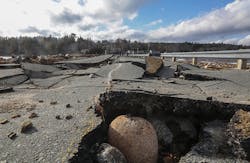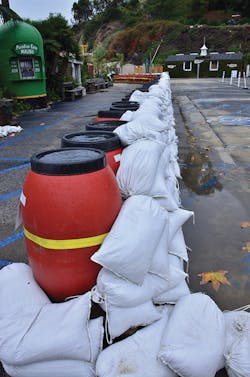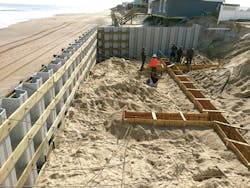Despite all our efforts to cope with her mood swings, Mother Nature definitely has a mind of her own, which perversely is actually a good thing. Throughout human history, fighting back her tenacious intrusion has been an ongoing and usually adversarial battle. However, there is no shortage of failure in those efforts. Crumbling and decaying vestiges across shorelines, rivers, and coasts are plenty of evidence that the most well-intentioned human interventions can meet those natural forces for only so long.
Seeking ever-new means that protect and forestall the impact of wind and water has become the genesis for scientific research, entrepreneurial innovations, and surprising outcomes.
While our longstanding designs and engineered solutions served an initial purpose, it is within a new set of parameters of working with nature, rather than against her, that will deliver sustained, long-term results.
As the climate changes, oceans warm, severe weather events increase in intensity, and sea levels invade ever further onto land, innovators have devised both practical products and environmentally beneficial approaches.
Many experts offer a wide range of predictions on the impact of changes and utility of solutions, but they all agree on one thing: we can’t sit back and do nothing.
Glacier Effects and Variable Shorelines
A four-hour ferry ride east of Portland, ME, lands visitors on the Canadian province of Nova Scotia, an “almost island” whose tides are recorded as some of the highest in the world.
Professor Ian Spooner, head of Earth and Environmental Science at Acadia University, describes the dynamics of erosion here, which are very different from the coastal erosion thousands of miles to the south in the Gulf of Mexico.
“While our shorelines are experiencing a sea level rise, the rates can be quite variable,” says Spooner. He explains that the phenomenon is a result of deglaciation. “Our land mass was the result of glacier movement and different ice thicknesses leaving at different times, resulting in what is known as differential isostatic rebound.”
The phenomenon is also called foreland bulge migration. Spooner suggests this action is similar to the energy transition that would appear as undulating waves if you watched in slow motion a flexible rope whipping against the ground. The same sort of thing is happening to the land mass, but over thousands of years.
“In other words, the province is facing a dual effect of rising seas and falling coastlines, along with highly variable tidal ranges. Our change in sea level has very different origins from that of a non-glaciated region such as the Gulf of Mexico or San Francisco Bay,” says Spooner.
One area of concern is the Bay of Fundy, a waterway between Nova Scotia and the main Canadian landmass to the north (New Brunswick province) that has recorded tides as high as 50 feet.
“This means that the shoreline is exposed to intense changes every day, with an impact on erosion compounded by an increase in intense storms,” he says. The postcard photographs of boats sitting on the sand, far below shoreline levels, or moored at the ends of piers extending far out into the water, depict this daily reality.
John Somers of the Nova Scotia Department of Environment, whose office recently shepherded the Coastal Protection Act (Bill No. 106) through Parliament, concurs with Spooner. “We have a widely varied coastline, and there is no one-size-fits-all solution, but protections from the new act will serve all those regions.”
Somers describes the thousands of miles of shoreline and the low lying areas: “These were originally diked by the first Acadian settlers, and on the Atlantic coast there are long swaths of hard granite, then the high tide region of the Fundy coastline.”
Of the Coastal Protection Act, he says, “It’s difficult to project what impact this will have on development, but another way to look at it is in the long term, how much damage can we prevent? This is a future-oriented piece of legislation that will prevent the sea level rise problems, arising from climate change and its impacts, from getting worse. Based on the best information available for climate change and relative sea level rise, we expect coastal erosion and coastal flooding will only become more serious in the foreseeable future.”
Somers says the objectives of the bill are sliding under a bigger umbrella that includes climate change mitigation, adaptation, and avoidance strategies.
“This is the initial step, passing the bill, then we work on creating the regulations. The legislation is the ‘what,’ and the regulation is the ‘how,’” he explains.
“This is really about regulating construction activities and restricting construction where it is going to cause environmental damage, or where resulting structures from that building will be at risk for inundation and coastal erosion.”
He says he was pleased with public response. “We had a huge range of opinion. People do expect us to take action; they expect us to be responsible.”
He adds, “When you talk to people, they understand in the long run it is a cost-saving measure. People will be increasingly spending money on repairs for infrastructure, or have their homes bought out from encroaching water. At the same time, we have many residents who make their living from the sea—we export a billion dollars’ worth of lobster every year, and our scallops, a noted delicacy, are shipped everywhere.”
Somers emphasizes that the sea is and “has been historically a way of life here, and we have to move with the natural forces. It’s not unlike the human-wildlife conflict; if you interfere with those forces you can cause damage. And there are really no huge associated costs associated with implementing the Coastal Protection Act, since the way it works will be through other legislation such as the Crown Lands Act and the Beach Act, and by regulating building permits. These [provisions] are there already, so it won’t add a huge amount of cost. The coastal zone protection will be delineated in more detail in the regulations.
“The bottom line is, in Nova Scotia, sea level rise is happening, unfolding in slow motion. It is inevitable, so it is worth taking action for.”
Waiting Out the Worst
While regulations can be a protective measure against inevitable events, sometimes you have to work a lot faster than the legislative process to protect people and property. And one natural disaster can precipitate another, as in the case of California. Wildfires that swept through the landscape were bad enough, but the subsequent rains, producing erosion and mudslides, increase the potential for damage.
Hawaii-based Barrier Systems LLC’s vice president, Jeff Knutzen, recognized the need to act quickly in the face of this type of disaster. He explains the influencing factors toward innovation of the company’s flagship product, the SandMaster sandbagging system.
“This was developed by the company president, Joseph Harley, who in 2009 was following the Red River Valley flooding efforts in the Fargodome,” explains Knutzen. “Millions of sandbags were being filled by thousands of volunteers, and he thought, ‘There has to be a way to make a machine do this.’”
The result was the SandMaster, a unit that attaches to a skid-steer or a backhoe and “can do in a few minutes the same work that volunteers would take an hour to do,” he says. “The unit is an attachment that has 20 or 26 spaced holes—we have two units to choose from—and you attach one of our specially designed bags into each hole. Then, the backhoe drives up to your pile of sand, scoops it up, and fills all the bags simultaneously to an approximate 50-pound weight in each bag.
“At this point,” he says, “you just drive that load of filled bags over to where you need them placed, partially release the trigger, and the bags drop part way to the ground, cinching them closed. Then you release the trigger all the way, dropping all the bags to the ground. Of course, you can load them onto a truck for delivery, but it makes much more sense to do all the operations right on your site, if you can do that.”
Knutzen says that a team of 20 to 30 volunteers can fill 3,000 to 4,000 bags a day by hand, whereas the machine with three people can fill 4,800 bags a day. He says the machine frees up volunteers to coordinate other relief efforts, and saves them from physical injury from continuous shoveling. “The labor on that just kills you.”
The SandMaster has other applications as well, he adds, and is not limited to bagging just sand. “You can fill them with rock, gravel, dirt, topsoil, and decorative aggregate. If you can bag it, you can use this machine.”
He says the machines require use of the company’s patented bags, which are made of a high-quality UV-protected polyethylene material. “You can leave them outside and they are resistant to the effects of ultraviolet light breakdown. Given that even in high-sun climates there’s probably not more than 12 hours of sunlight a day, and usually not every day, these will last for almost a year outside.”
Keeping Paradise Open for Business
Bob Morris, owner of the Paradise Beach Cafe in Malibu, CA, credits the machine for saving his business during the devastating 2018 Woolsey Fire that burned almost 100,000 acres of land in Los Angeles and Ventura County.
“This fire went for miles, 20 miles to the north and 18 miles inland, and our beach restaurant location was at high risk. We have a stream channel right next to us whose runoff dumps into the ocean. In the middle of this fire, the federal government sent in some debris flow-control experts and they showed us that there were about 15 miles of debris and potential for flooding.
“I knew right then we were in for big trouble, and the flooding from this could wipe us out, so I decided to make sandbags right away to protect this property,” says Morris.
He purchased a SandMaster and made 10,000 bags to control flooding around the restaurant site. “We were on every television broadcast as ‘The Great Wall of Paradise Cove,’ and the good news is while the flooding never came, we did have big rains, and we were kept safe. We were the only business that was still open around here. The machine worked great, and it has so few moving parts it doesn’t need any maintenance; it keeps on scooping and filling. I’d say the machine paid for itself the first day of its use.”
Meet-in-the-Middle Technologies
“Our evolving climate means that coastal property now has different challenges,” says Doug Zacharias, vice president of sales and marketing for Atlanta-based manufacturer CMI Ltd. Co. “Many of these areas were successfully built out years ago, but now they are experiencing rising water problems. What may have been in standard land-use zoning is now in a floodplain, whether officially recognized as such or not.”
Zacharias says residents and businesses need protection while still desiring the same access. “Much of our daily work is focused on helping customers keep water in check, where they want it—in most cases, away from their assets. Protecting shorelines and improving access to real estate assets are at the core of our company mission and what inspires us to develop innovative-sustainable products that become solutions to that end.”
He adds that like many things in life, when it comes to property development, “if you can develop a way to scale the solution, it generally benefits all. In other words, it becomes more cost-effective if everyone can get on board with a combined solution. If one guy puts up a seawall, he has basically created a moat around his property, and the rest of his neighbors are no better off—and in some cases, possibly worse.”
Zacharias explains that changes in actual flood stage levels also create changes in drainage patterns, which create new issues that can require attention. He says his company tries to be a resource by offering education and awareness to all concerned constituents—engineers, municipalities, and property owners—urging them to be proactive. It’s critical that municipalities facing sea level rise “focus on awareness and education,” he says. In some cases, modifying the original design of a property is necessary, even if it’s less than 10 years old, because of accelerated flood episodes.
“Once people understand the risks and accept that they are very real, they can work together and find a common ground so that their properties are protected. Municipalities generally think and operate in terms of codes and regulations only. Unfortunately, in some cases the minimum requirements are behind the reality curve. We help them by providing perspectives from our 25 years of expertise in collaboration with theirs to develop progressive solutions that can exceed code without additional costs.”
He adds, “There is going to be more and more reclassification of real estate in the coming decades. We hear people say, ‘I can’t sell it because it’s worthless,’ and what we can do is help them address their real flood exposure, and by engineering and proper techniques help divert the water to protect those assets.”
He says, “We see a trend where there is an aversion to man-made engineered materials, but very often an all-natural shoreline solution, while well intended, just can’t hold up and can get washed out depending on the severity of the exposures. Bringing the best of both worlds—the natural and man-made products—together can be not only an answer to protecting assets, it can look good, keep the shore intact, and last a long time. Picture the foundation or core of the solution being engineered, man-made materials covered or surrounded with natural materials to create fully engineered high performance with soft natural aesthetics.”
The company’s ShoreGuard sheet piling comes in more than 40 different profiles, varying in thickness from 0.25 to 0.75 inches and in lengths up to 80 feet. Different colors and flat or corrugated shapes allow customers to customize the appearance. “Many of our customers focus only on the structural part of the solution, but there is no reason to not make it look good while doing its job,” he says.
Navy-style walls incorporate additional horizontal and vertical support in front of the wall material, typically marine-grade treated dimensional and pile lumber members. “The TimberGuard marine lumber system incorporates polyethylene-encapsulated, pressure-treated dimensional lumber piling poles as a longer-term solution,” he explains. “TimberGuard is specified by many municipalities that have concerns with water contamination created by traditional treated lumber.”
The sheets themselves can also be installed with several different aesthetic finishes including woodgrains on the face for a more natural appearance. The top cap of the seawall can also be provided in a variety of synthetic or treated wood materials.
Incubators for Sea Life
One organization working to mobilize new solutions with the private sector is the Galveston Bay Foundation, a not-for-profit organization that living shorelines program manager Lee Anne Wilde says is involved throughout the shoreline of the 600-square-mile bay.
“One of the challenges is that in Texas, 95% of shoreline is privately owned, but in our 36-year history we’ve found that working with individuals on a small scale is a viable way to achieve results,” she notes.
She says most people want to put in a concrete revetment or a bulkhead to stop erosion on their property, but that’s often not a good solution. “This really only exacerbates the problem as the waves scour around them, and then you have a huge wall with collapsing soil and water behind it that ultimately is a huge cost to take out or repair.”
Advocating the living shoreline approach, Wilde explains that it “incorporates building a breakwater about 50 to 75 feet offshore, even 100 feet—we are a very shallow, sloping bay. We use clean concrete made especially for us from our vendor, Gulf Coast Limestone, rather than old road material, which often has rebar in it that will rust and is dangerous. The rock is loaded onto barges, and track hoes are used to stack the rock in a trapezoid shape offshore. The structures measure approximately 3.5 feet high and anywhere from 15 to 27 feet wide at the bottom.
“Gaps are incorporated every 50 to 100 feet so that organics and nutrients can come in and out. As the waves trip over the breakwater they are robbed of energy, so they drop their sediment, and this sediment drops on the landward side and collects there.”
After a period of time, waiting for enough sediment to be deposited, “We can then plant marsh grass. This is the start of our living shoreline. As we accrete more sediment and it becomes deeper and the grass grows, we are suddenly creating a band of habitat. In our area we use smooth cord grass, which is a native species, and then this area becomes a mini-marsh.
“The next thing we see is that this marsh becomes a nursery ground for baby crab and shrimp, who can take refuge from predators. Then the birds come and, as the grass grows, the roots interlock and it becomes a fantastic mat that holds the soil in place.”
Wilde adds that from an erosion control perspective, this soil-holding capacity is a good thing that only gets better.
“As the grasses get thicker and the landward edge of the marsh gets higher and drier, other mid-marsh species will come in, as well as other plants that like this drier environment. The elevation of the land gets higher, and the grasses trap more sediment, allowing the front edge of the marsh to migrate seaward. This is what happened in the rebuilding of the mangroves. Very slowly as the land grows, they migrate toward the sea, and the five-foot bluff behind the marsh, as it begins to slope seaward, becomes a three-foot bluff.
“The land isn’t lost, it’s just grading outward, and at that point you have a pretty stable shoreline. Even if you have a storm, the grass will attenuate the energy.”
Wilde says that right now the organization is overbuilding the breakwaters to accommodate sea level rise. “If you look at a map of Galveston Bay Eagle Point on the east, it was historically shallow enough that you could drive cattle across at low tide,” she says. “But oysters were mined for a variety of uses, so we destroyed those beds, and then we cut a ship channel, and now shipping vessels throw up large wakes and that eats away at the shore, so it has all changed.”
She says that marshes that are not armored will creep landward and are a natural erosion guardian.
“We can’t assure anyone that we can protect shorelines in perpetuity, especially as storms get stronger, but the best we can do now is to protect coastal regions with the techniques that we know work and give nature a fighting chance.”
Predicting Outcomes
More than a thousand miles to the northeast of Galveston Bay is the Chesapeake Bay, another vulnerable body of water and one now recognized as having a 20% higher risk from sea level rise than any other US shoreline. Recently, experts studying sea level rise in the Chesapeake Bay and forecasting its effects have discovered some surprising outcomes from their modeling studies.
“What we already know is that coastal inundation is affected by sea levels and by the changing tides. Current estimates of how the rising sea levels are going to affect coastal communities has been done by simply adding the sea level rise predictions to the present-day tides and forecasting impacts from this change,” explains professor Ming Li of the University of Maryland Center for Environmental Science (UMCES).
However, there is another component that changes the whole picture, Li adds.
“Tides themselves are affected bythe changes in water depth, so if sea level rise increases that depth, then it follows that the tides will similarly change, and this affects the position of high and low tides.
“In our study, we looked at howsea level rise would affect the tides of both the Chesapeake and Delaware Bays, and then through modeling techniques looked at the effect of coastal inundation if shoreline protections are put in place.”
Li says there are huge implications in the type of shoreline protections being used. People living close to the water whose investments are threatened want to protect their assets at all costs, “but if everyone were to collectively erect seawalls and keep their own backyard dry, this ends up sending the water somewhere else. And what we found is that when this happens, it forces water higher into the upper parts of estuaries, so you really haven’t solved anything and in fact have made it worse.”
But there is good news from the study regarding low-lying land that is allowed to become inundated naturally and thereby broadens the area of a waterway to produce more friction for tidal currents. “When this happens, the higher sea levels will reduce the tides,” says Li. “The model and its predictions for the Chesapeake and Delaware Bays are a fairly clear indication of what could happen when coastal protections are put in versus no shoreline protections.”
His study suggests that communities planning to put armoring in place would find that these bay waters are forced to move further into their upper reaches, “where major cities are located that will see a far greater impact on their coastal inundations than expected from sea level rise alone.”
The study was published as “Impact of Sea Level Rise on Tidal Range in Chesapeake and Delaware Bays” in the April 2017 Journal of Geophysical Research: Oceans.
He says, “I tell my neighbors that we have to allow these low-lying areas to flood for two reasons. The first is that gray armoring and protections will not necessarily help you, and over time, the scour will break these down in any case, which only worsens the erosion they are trying to prevent.
“Second, we have to consider green solutions, as these principles demonstrate that collectively adapting with nature, rather than against it, can minimize the effect.”
For example, based on the research modeling, Li says that the water level increase of 2.5 meters that occurred during Hurricane Isabel “would be double that in 2100 if high shoreline protections are in place.”
He says, “We have to work with nature, implement the policies that require building elevations, move to higher ground, stop bringing infrastructure to the water’s edge. We need to allow these low-lying areas to remain and to dissipate the energy that threatens our communities and increases property, financial, and personal risk.”








